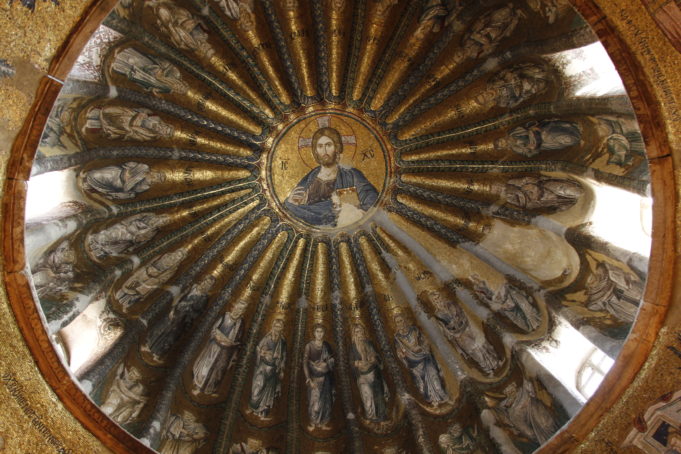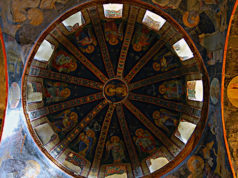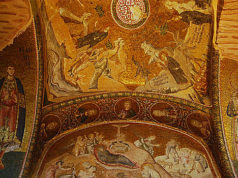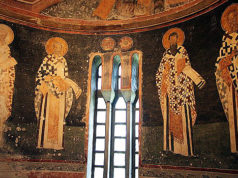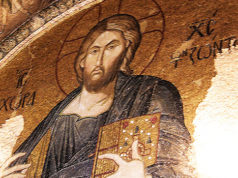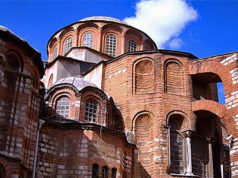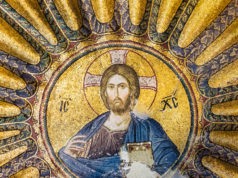The Kariye Museum (Chora Museum) is one of the historic showplaces of Istanbul. 80% of all foreign visitors to the city manage to get to this fascinating museum in itsrather out of the mainstream part of Istanbul. In fact it is surprisingly easy to get there under your own steam and without recourse to taxis. The number 28 bus leaves regularly from Taksim Square, travelling through much of the city running parallel to the Golden Horn, and ends up at its terminus near to the Edirnekapi Gate. The Kariye Museum is only a short walk away from the bus terminal, and features some of the best and most famous examples of Byzantine art in the world on its walls and ceilings.
When you alight from the bus you will find that your walk to the museum takes you into one of the picturesque backwaters of Istanbul, past restored old wooden double-storeyed houses, their carved balconies sometimes hung with washing. You may end up with a group of children following you as you stroll through this attractive part of Istanbul. Soon you will emerge into a small square completely dominated by the bulk of the church building, now a museum, with its main entrance opening onto the square.
Nearby stands an old Ottoman fountain, and surrounding the square are more restored old wooden buildings, the ground floor of one of them having been transformed into a cafe. The area that you have walked through, as well as the streets and buildings around the square, have all been faithfully renovated and restored by the Turkiye Turing Otomobil Klup, headed by the indefatigable Celik Gulersoy, who is responsible for a restoration programme in Istanbul that included many old buildings — houses, villas and summer kosks in the city.
The present church building dates to the 12th century. This gracious late Byzantine edifice is coloured in warm earth and ochre tones, and is surmounted by domes and semidomes. At one side stands a tall minaret — relic of the building’s conversion into a mosque. Behind, are the gardens from which you will have a better idea of the true size of the church.Some historical notes
This building is the last of several churches and monasteries that have stood here since the 5th century — with the name of the Church of Saint Saviour in Chora or the Church of the Chora, or the Church of the Monastery of the Chora. When the church was converted into a mosque in 1500 the name Kariye Mosque was given to it. The word “Kariye” like “Chora” means “in the country”. When somany important churches and mosques were turned into museums by Ataturk in the 1920s, this building became Kariye Museum — its name today.
Originally it is thought a church was built here in the 5th century under the Emperor Theodosius. It may at that time have been outside the smaller city’s walls, hence the name given to it as being out in the country, and later, as the walls were built around the expanding city, the church would have found itself inside the new and much longer city walls. Due to damage from the earthquake of 558, the church was rebuilt in Justinian’s reign in the 6th century to become a Justinian monastery.
In the 12th century the building was reconstructed and extensively restored with the finances of Maria Dukaena, mother-in-law of the Emperor Alexios I Komnenos. It was rebuilt on the foundations of the former monastery that had stood here. Early in the 14th century Theodore Metochites undertook the last rebuilding, expansion and restoration of the building, and the present edifice dates to this time.
The responsibility of upkeep, restoring, renovating or rebuilding church buildings used to belong to the ruling family, and in return they were given the title of “Founder”. The founder and family members were also honoured by being featured in the church’s decoration, sometimes in the form of portraits or panels portraying one or more of them. This is the case in the Church of the Chora, which has traditionally been financed and supported throughout the centuries by the ruling dynasty.Theodore Metochites
Theodore Metochites lived circa 1260-1332. He was born in the Constantinople of the late Byzantine Empire, of a wealthy and influential family. However, his father, George, had strong opinions regarding the union of the Byzantine church with the Roman church. This resulted in the family being exiled from the city. The boy Theodore early on appreciated the importance of learning and education and decided to become a scholar. Accordingly he studied many subjects, among them philosophy, sacred books, theology and ancient literature. Before the age of 20 he had written and composed eulogies of the saints, literature and writings on Greek history. In the event he became a politician.
Living in Nikaea (present-day Izmit), he came to the attention of Emperor Andronikos II, who was very impressed with him and offered him a position in the palace, even though at the time his father was in the state prison. He quickly advanced and at the age of 36 became prime minister. Through the marriage of his daughter to John Palaeologos he became related to the ruling family. His private fortune had increased at the same time, and in 1316 he began the restoration of the Monastery of the Chora. One of his declared aims for doing this was to immortalize his own name. It has also been speculated that he had an idea of what was to happen to him in the future and by restoring the monastery was already anticipating it.
Metochites used his own money and that of the state for restoration, and he ensured the monastery an ongoing capital by assigning to it the incoming revenues of some vineyards and farms. He added some extensions to the original building, enlarging it considerably as well as rebuilding the large central dome. After the building was completely restored work was begun on the mosaics and frescoes inside. In 1321 Metochites was given the position of Grand Logothete, the controller of the state treasury and the highest position in the Byzantine Empire.
However, all was to come to an end in 1328 when civil war broke out between the emperor and his grandson. As an official of the state Metochites was exiled to Thrace, his palace was destroyed and all his properties and wealth were confiscated. Metochites by 1330 was a povertystricken old man. However, he used an obscure law in existence in the empire which stated that if the founder of a monastery had become destitute through no fault of his own, he had the right to demand support from his foundation. Because of this law he was allowed to return to the monastery, where he became a monk called Theoleptos. He died in the monastery two years later in 1332, and was buried in the paracclesion.The mosaics and frescoes in the museum
The mosaics and frescoes of the Chora are some of the best examples of later Byzantine art to be found anywhere in the world today. Dating to the 14th century and the time of the restoration by Theodore Metochites, they have been cleaned and restored by the American Byzantine Institute and are in quite a good condition. I once met Professor Underwood, the renowned American Byzantine expert on the Chora, and he informed me that it had taken eight years for he and his team to complete the restoration of one wall only.
This was when he was working on the Anastasis — the scene where Jesus is shown pulling Adam and Eve out of Hell. Watching Jesus from each side and in the background of the scene are some of the Righteous. Satan has been bound in chains and writhes under Christ’s feet. Incidentally, this scene is considered racist as Satan has been portrayed as being black.
Over the front entrance of the building is placed the figure of Theodore Metochites. He is offering the Monastery of the Chora to Christ. Panels near the front entrance of the Chora show other founders of this monastery/church and members of their families as described earlier. What sometimes confuses foreign visitors to this church and other places in Turkey and elsewhere that feature Byzantine art, and at the same time is not helped by the lack of knowledge by some guides on the subject is that, to a large extent the Eastern Orthodox Church uses the Apocrypha as well as the Old and New Testaments, and many of the scenes found in the mosaics and frescoes of Byzantine art are taken from the Apocrypha. As Christians and those with a Christian background who are not of the Eastern Orthodox Church are often not particularly familiar with the Apocrypha, visitors to the church may never have heard of some of the events that are featured in it. This is the situation regarding Byzantine art anywhere.
For example, the life cycle of the Virgin Mary commonly features in Byzantine art and the Chora is no exception. There are scenes from before the Virgin’s birth that depict her parents. Her mother Anne, had been unable to have a child and was very unhappy about this. One day an angel appeared to her and said she had been chosen by God to give birth to a daughter. The daughter would become the mother of the Messiah, the long awaited King of the Jews. Anne was overjoyed at hearing this and rushed home to tell her husband the good news.
As well as this history being featured, there are scenes of the Virgin as a baby and as a child gradually growing up. They show Mary as a baby taking her first seven steps towards her mother. There are also scenes showing her being approached by the angel Gabriel and learning something of what was to come in her life. The deathbed of the Virgin Mary is also featured, with all the apostles standing around her — they are easily identifiable, and in Byzantine art they are always featured with their own characteristics. For example Saint Paul is always featured as being a much older man with a bald pate surrounded by a ring of hair. Poor man, he has gone down in history for ever with that image. On the other hand Peter is always shown as being a young and handsome man in the prime of life, and he will always have this image in the church.
Joseph’s history is also featured to some extent, although the New Testament tends to push him into the background. His two very grown up and adult sons are also depicted, and in one scene Mary is riding a donkey surrounded by the three men: Joseph and his two sons. One scene shows the story of how Joseph came to be chosen by the priest from several other men for his unique task of bringing up the Messiah. As these men were all in the presence of the priest, the wooden staff that Joseph held in his hand suddenly sprouted green leaves in front of everybody. This miracle was a sign from God that Joseph was the chosen one to be the husband of 12 year-old Mary.
As well as the scenes showing the life cycle of the Virgin, there are also scenes at the Chora depicting the life cycle of Christ. The massacre of the children by Herod’s soldiers is also shown, though some of this mosaic is missing. The faces of the mothers as they see their baby sons being killed by the soldiery are full of anguish and very lifelike. One soldier is holding a baby by its feet as he dashes its head against a wall or rock.
Also depicted is the Holy Family’s flight to Egypt, and again their return to Nazareth. The genealogy of the Virgin and Christ are shown separately and on the ceilings. A number of the miracles performed by Jesus and mentioned in the New Testament are also depicted in mosaic. These include Christ healing a leper, the changing of the water into wine at Canaan, the healing of the paralyzed man, the healing of the blind man, the miracle of the loaves and fishes and a number of others. Another section of the church shows a series of the saints and there is another series depicting the church fathers in mosaic.
After looking at the art decorating and covering much of the church interior, you can stroll around outside in the gardens of the museum and take photos of the outstanding views to be seen from the grounds. This is a museum that can be visited many times as there always seems to be something new to discover.In the vicinity of the Kariye Museum
The city walls of Theodosius are within easy walking distance of the museum and are well worth exploring. Set into them in this part of the city is the Edirnekapi Gate. The road leading out of this ancient city exit leads eventually to Edirne in Thrace; Edirne was a former capital of the Ottoman Empire. Further along the city walls and standing against them are the ruins of the Tekfur Sarayi or the Imperial Palace. This is believed to have been the palace of Constantine Porphyrogenitos in the 10th century. Further along again stand the ruins of the once magnificent Blachernae Palace built by the Emperor Alexios I Komnenos, to where the imperial court was transferred in 1150 by the grandson of Alexios, Manuel II.
After the capture and ransacking of Constantinople by the Frankish and Latin crusaders of the Fourth Crusade in 1204, the Latin rulers lived in this palace in great luxury. When the city was recaptured from the Latins by the Byzantines however, the Palaeolog ruling dynasty lived in the Blachernae Palace in poverty — everything having been destroyed or stolen by the Latins. From here in 1453 the ruling family would have seen the gathering of the Ottoman forces outside the city as they were preparing for their massive (and successful) assault against Constantinople on the other side of the city walls. This part of the city is rich in Istanbul’s historical past.
By Anita Gillett / Turkish Daily News


